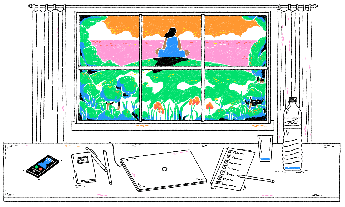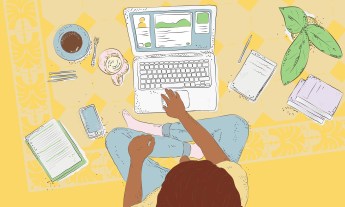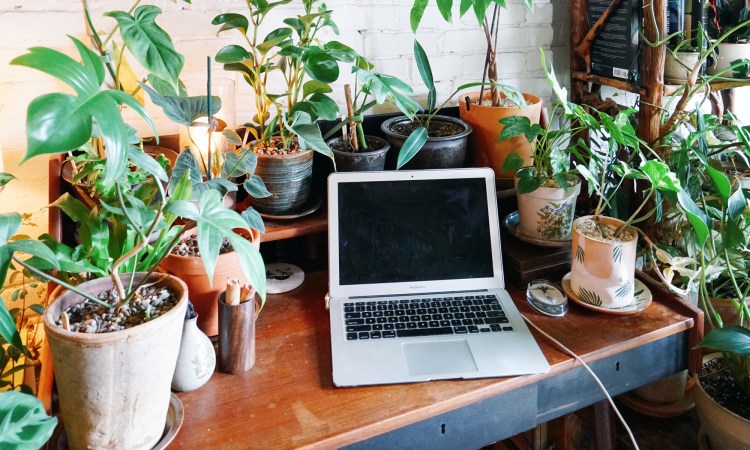
Some people love working from home, and they can’t imagine anything better than a day with their laptop clad in pajama pants. Others miss the structure and the casual chats with coworkers that happen at their offices. Whether you love it or hate it, working remote — for those who can do it; not every job lends itself to this kind flexibility — is common for many of us due to the pandemic.
For those of you new to working from home, there’s lots of advice out there about how to deal with the pitfalls and stay productive and sane (“Take a shower!” “Don’t spend too much time on social media!”).
But from my own experience, working from home can be a real delight if you let it. So I’d like to share a few ideas for creating a workspace and routines that will make working from home a joyful, sustaining experience. And who knows? You might not even want to go back to the office!
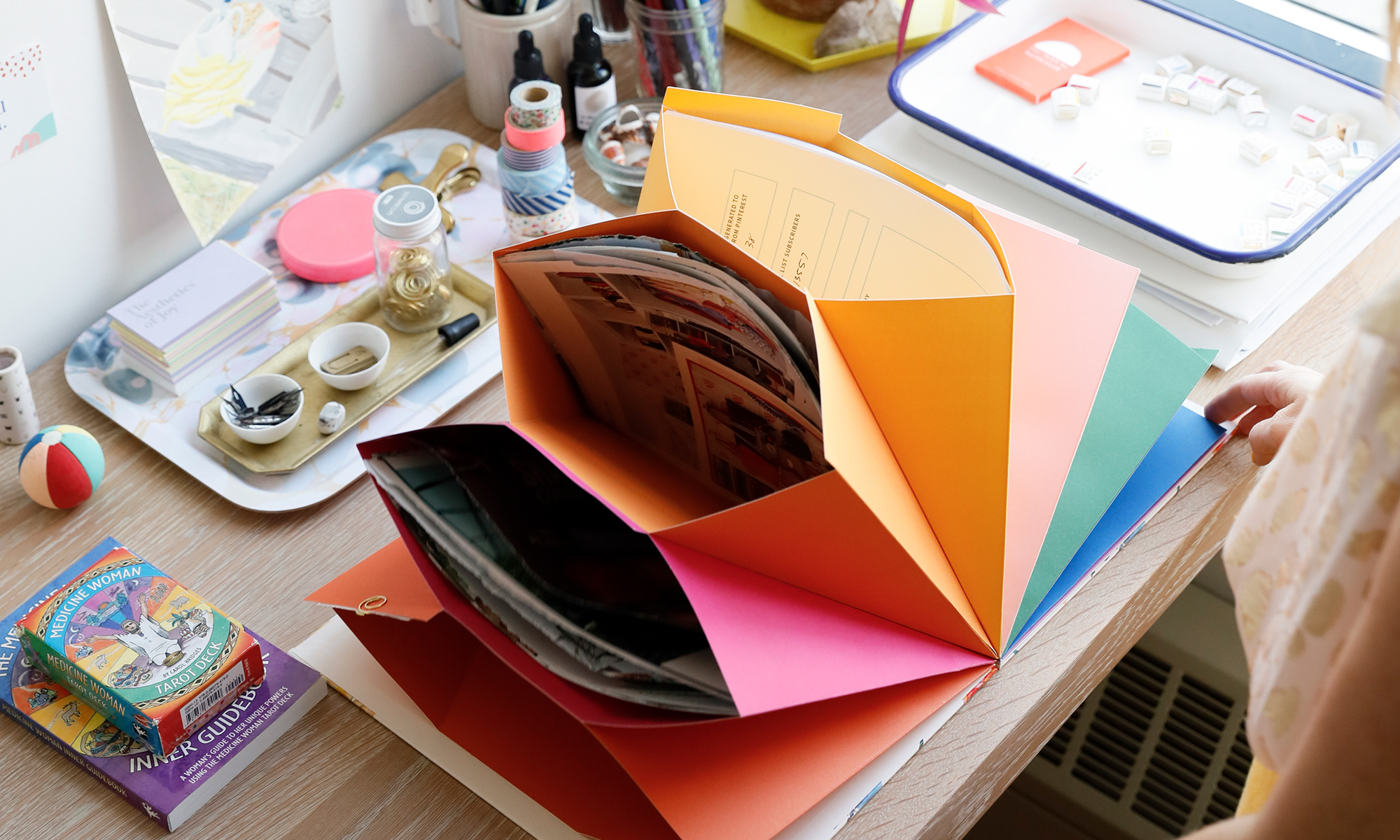
1. Take care of your body
In her book Proposals for the Feminine Economy, Jenn Armbrust offers a series of principles, the first one being: “You have a body.” Sounds simple, but working from home can make it easy to forget about your body’s basic needs. At your office, you probably had an ergonomic desk chair or an adjustable workstation. However, unless you work from home regularly, your workspace may consist of a kitchen table and basic chair.
You don’t need to invest in a whole home-office setup, but rather pay attention to how your body feels as you work from home. One advantage to working from home — as opposed to being in an office — is that you can change positions frequently. Try out lots of postures, whether that’s sitting in a chair, standing at your kitchen counter, relaxing on the sofa, or sitting on a yoga block on the floor with your coffee table as a desk. It took me a long time (and some serious shoulder pain) to realize that the best position for long writing stretches for me is sitting on a backless bench at my dining table. Testing different positions can help you find physical ease faster.
Another thing to pay attention to is movement. You likely do some walking in the course of an office workday — to the office from the train or bus or parking lot, between meetings, to the café for more coffee — and these movement breaks disappear when everything you need is within a couple of rooms in your home. When I first started working from home, I was surprised to find that I sometimes got in fewer than 1,000 steps in a day!
The flexibility of home work means, though, that you can largely move when you want to. Try setting a timer for a yoga or workout to break up a long email session. While writing my book Joyful, I took impromptu dance breaks whenever I was stuck on a section, which cleared my head but would’ve been hard to do in the office. I also started to take a long walk in the park at the end of every day. In the summer, I’d print out the latest draft and take it with me and sit in the shade while marking it up. In the winter, I’d do this at the kitchen island after coming home.
2. Use your commute
How long was your pre-pandemic daily commute? For many people, it can range between 30 minutes to 2 hours (or more), round trip every day. It also really adds up. Even at the short end, that 30 minutes per day adds up to two and a half hours that you’ve now gained per week!
The key is being intentional about how you use that time. Schedule it in your calendar — it doesn’t have to be at the same time as your commute — just as you would a meeting.
You can also block that time out for free, unstructured time, something most adults don’t get enough of. But then make sure to put tools down when the calendar alert goes off and give yourself space to enjoy it.
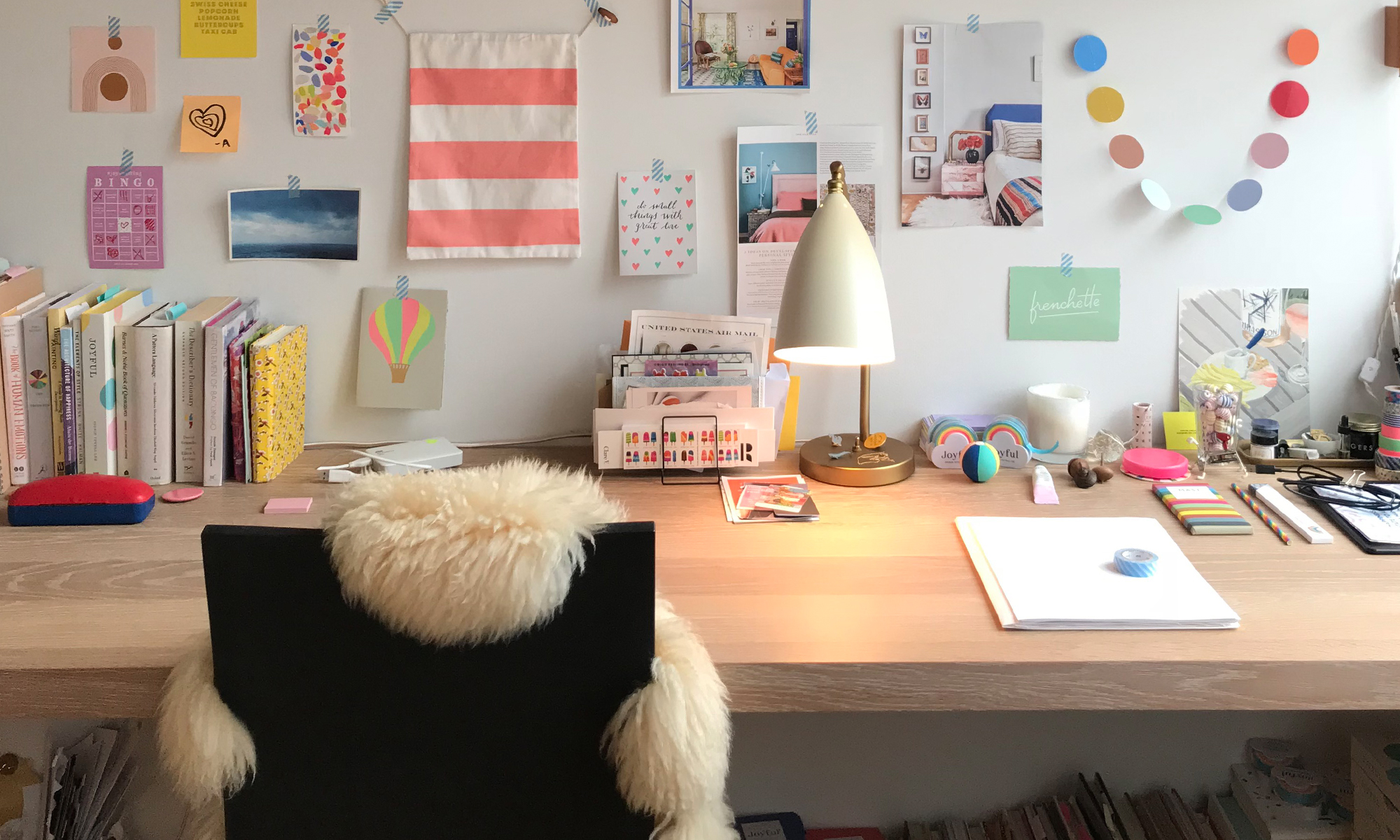
3. Create a sensory landscape
With their dull color palettes, synthetic carpets and humming HVAC systems, most workplaces have a joyless sensory landscape. Add in the noise from open-plan seating, and the fact that many spaces are often too cold or hot, and the typical office can be deeply unpleasant to spend time in, much less get focused work done.
While many of us often see the problem as overstimulation, in fact offices are just as likely to be understimulating. Workspaces have traditionally been designed based on the belief that to maximize productivity you need to minimize distraction, leading to bland, featureless spaces. But research shows that when people in these “lean” workspaces are compared to people working in “enriched” spaces that have art, plants, and more sensorial stimulation, the workers in the enriched spaces are 15 percent more productive. And if the workers have control over the placement of things in their workspace? They’re 32 percent more productive.
When you work from home, you can be like those workers in the study who controlled their own workspace — and create a sensory landscape that works for you. Part of this may mean eliminating unpleasant sensations, by getting noise-cancelling headphones to tune out distracting noises or adjusting the temperature so that it’s comfortable for you.
Also, look for ways to add pleasant sensations into your workspace. Hang up an image that gives your gaze something to rest on while you glance away from your screen. Play nature sounds. Choose a brightly colored mug for your morning coffee.
The senses of touch and smell are particularly understimulated during the hours we’re tapping away at a keyboard, so look for ways to appeal to them. For example, I cover the bench I sit on when writing with a sheepskin, which has a decidedly unofficelike soft texture. I keep a bottle of essential oils on my desk, and sometimes use a diffuser to scent the air.
4. Get some sunshine
One poorly designed aspect of many traditional offices is how little daylight exposure is available in workspaces. For most workers, the only light during the day comes from the dull fluorescents overhead. Yet research shows that workers who get more exposure to daylight sleep better (up to 46 minutes more per night), are less stressed, and are more active during the day. Light regulates key hormones and neurotransmitters, influencing everything from our alertness to stress levels, our immune system to our moods.
In your home, you have more control over where you choose to work, so if possible, choose a space near a window. And if you don’t have much natural light in your space, use lamps to boost the brightness. Just as too much blue light from our screens can keep us up at night, a healthy dose of bright artificial light during the day can also help keep our 24-hour internal clock in sync.
Also, when you used to commute to work, you likely got at least a little sunlight on the way, which you lose if now you jump straight into work first thing. Light has the greatest impact on our circadian rhythms in the morning, so try to go outside for a brief walk before you sit down.
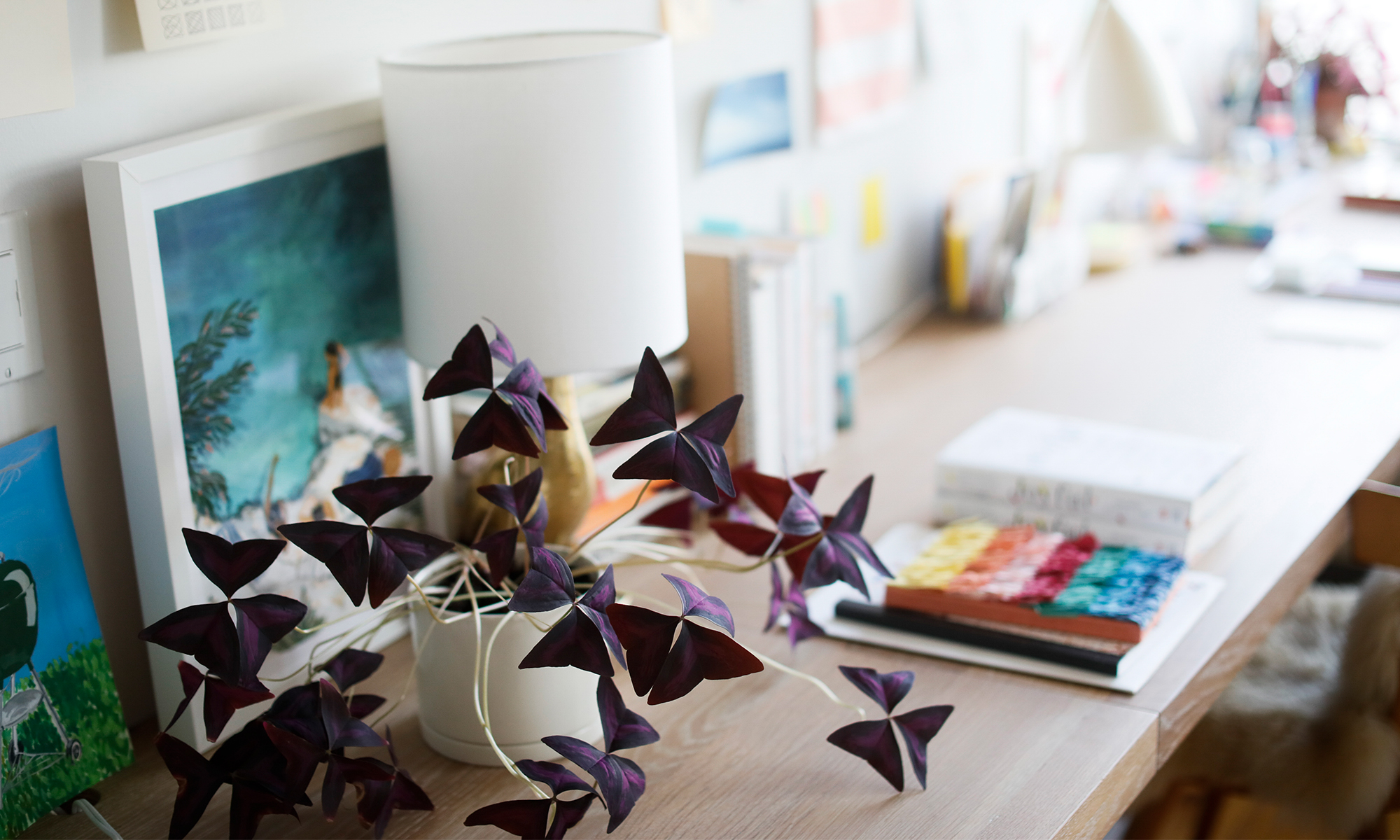
5. Green your workspace
One simple thing to do to make your workspace more joyful is to add greenery. Plants that might struggle in the dim light of an office can thrive in your home, and you gain the extra benefit of getting to enjoy them when you’re not working as well. You don’t have to have as many plants as Summer Rayne Oakes does in her home workspace, but even just adding a few has been shown to reduce stress and restore your ability to concentrate.
6. Make a “get to work” playlist
One challenge I’ve found in working from home is transitions. It can be hard to stop doing all those home things (emptying the dishwasher, folding laundry, etc.) and get down to work, especially if there’s work you’re avoiding. In fact, many writers joke that their home is never tidier than when they’re working on a book.
One thing that helps is having some sort of ritual that marks a transition into a work session. I have a couple of “Get to Work” playlists that help with this: one for writing, one for email. The playlists always start with the same song, so it becomes like a sonic trigger that primes me to focus.
Other transition ideas might be pouring a fresh cup of tea or coffee, doing a quick stretch, or setting a focus timer (I use the Tide app on my phone).

7. Make snack time special
A lot of work-from-home guides advise you to take a real lunch, but I confess that when I’m in flow, I much prefer to eat at my desk. This doesn’t mean that I don’t believe in taking breaks, though. As I mentioned above, the most important features of breaks for me are to get outside and to incorporate movement into my day.
I also love a good snack break. We often think of snacks as fuel, but for me, they’re more of a treat. And, as writer Gretchen Rubin has pointed out, treats can help make us feel cared for, energized and motivated. Having access to your own kitchen means that you don’t have to rely on the processed foods that constitute a snack in most offices, nor do you have to eat it out of a bag.
I’m a big fan of cutting up fruit and arranging it in a wheel around my plate, or making little sampler plates from the fridge of pickles, olives and other nibbles. I also make energy balls or banana bread and freeze some so I can have it for a mid-week treat. You’re your own office manager now, so think about what would make you feel cared for and create space for it in your daily routine.
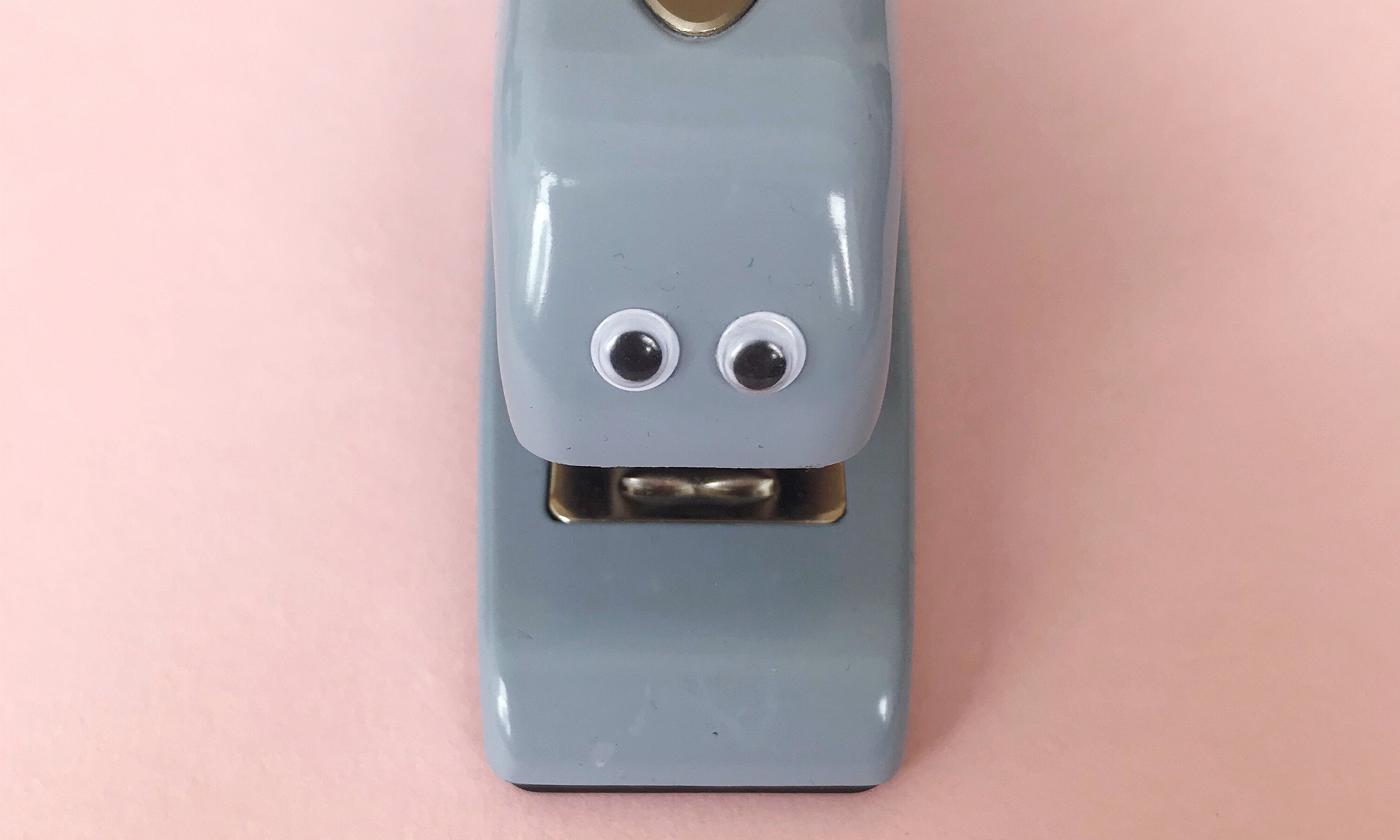
8. Be playful
Offices have been designed with work in mind, and the prevailing view is that work is somehow the opposite of play. But, as play researcher Brian Sutton-Smith says, “The opposite of play is not work. It’s depression.” Bringing your work home gives you a chance to invite more play into your workflow. And this can start with your workspace.
A playful workspace creates more opportunities for play in your day. These can be small, like the miniature spinning tops I keep on my desk to spin when I get stuck on an idea, or they can be larger, like having a trampoline to bounce on or a hula hoop to play with. Changing out a desk chair for an exercise ball can also bring a sense of play. A giant bowl of Legos or a big puzzle can keep hands busy while your mind is working through ideas.
You can also experiment with adding playful forms of decor, like children’s drawings on the wall, or cute objects for your desk. I put googly eyes on my stapler, for instance. Cute things may even benefit our productivity, according to research out of Japan, by enhancing our ability to focus.
Imagine: If you’d never been to an office before, what would you want it to look like? When you work from home, there’s no reason not to create a space that lets your imagination run free.
9. Pack it up and put it away
Perhaps the worst thing about working from home is that it’s hard to know when the workday ends. Writer Kevin Roose has found, for example, that remote workers take shorter breaks and fewer sick days, suggesting that boundaries can be an issue. This is even more challenging if you don’t have a dedicated home office space. When your laptop sits on the dining table or your coffee table is covered in stacks of folders, it’s hard to fully feel like you’ve turned off.
This is one reason why I insisted on building in two tiny home offices in our current renovation. I still will probably spend time working at the dining table, but I wanted a place to put everything at night so that I can close the door on it and not be distracted by the things I didn’t get done.
You don’t need a spare room to do this, though. Simply having a basket or closet to tuck your laptop and papers into at night will do the trick. Creating a physical boundary will help you reset your mind and reclaim your home as your home.
This post was originally published on The Aesthetics of Joy site.
Watch her TED Talk now:









